Documentation for Application Programming Interfaces (APIs) is one of the most difficult types of technical documentation to write.
Nevertheless, as the exciting field of API development keeps evolving and growing, the need for such documentation has never been greater.
If you’re struggling to even begin understanding how documentation can help developers using APIs in their work, this guide will provide you with a primer on what API documentation is, why it’s important, and how to create it efficiently.
So, let’s get the basic definitions out of the way and start learning about API documentation. Here are also some API documentation best practices you can follow for a better approach.
What Is API Documentation?
APIs are highly complex software products that allow developers to create a bridge between two software systems and enable them to communicate with each other.
In order to successfully integrate APIs into their own products, these developers need detailed guidance that will explain the capabilities of the API and how to begin working with it. Here's how to get more developers to use your APIs.
That’s where API documentation comes in. It provides a complete resource for developers to get acquainted with the API, learn to integrate it into their work and solve any problems along the way.
For example, have a look at what the documentation for Twitter’s API contains:
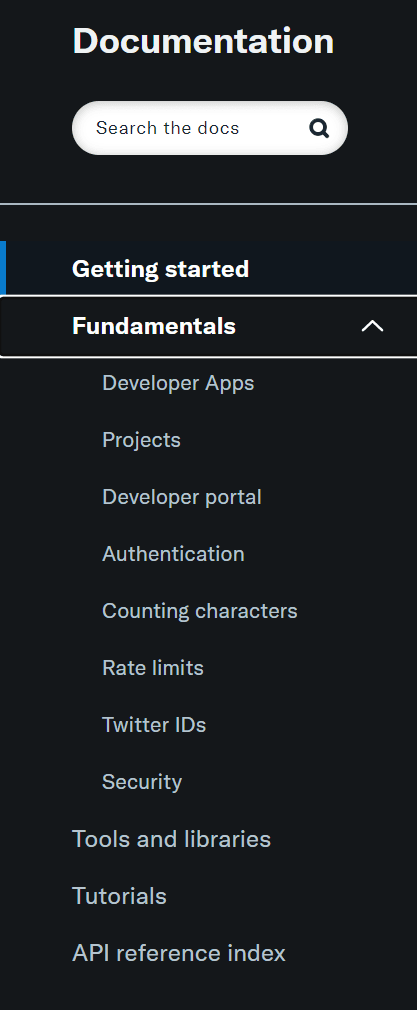
Source: Twitter
As you can see, there’s a logical place to get started, followed by guides for the fundamentals that make up the API, tools for documenting your APIs and libraries where developers can find everything they need to work with the API, as well as tutorials that foster self-learning to help developers become proficient users.
Finally, there’s a reference index where developers can quickly look up every action they can take using the API.
API documentation is usually written by technical writers who are well versed in code or even the developers who created the API themselves, as they are the ones who are most familiar with the API and its features. We made a blog post about tips for writing great API documentation you might wanna check out, and also our seven steps to writing API documentation.
In most cases, the documentation is then uploaded to a dedicated documentation website so it can be accessed by interested parties who want to learn about the API and get ideas on how to use it to achieve their goals.
Here's a guide about how to write API documentation you might want to check out before continuing.
Here’s what Google’s API documentation site looks like.
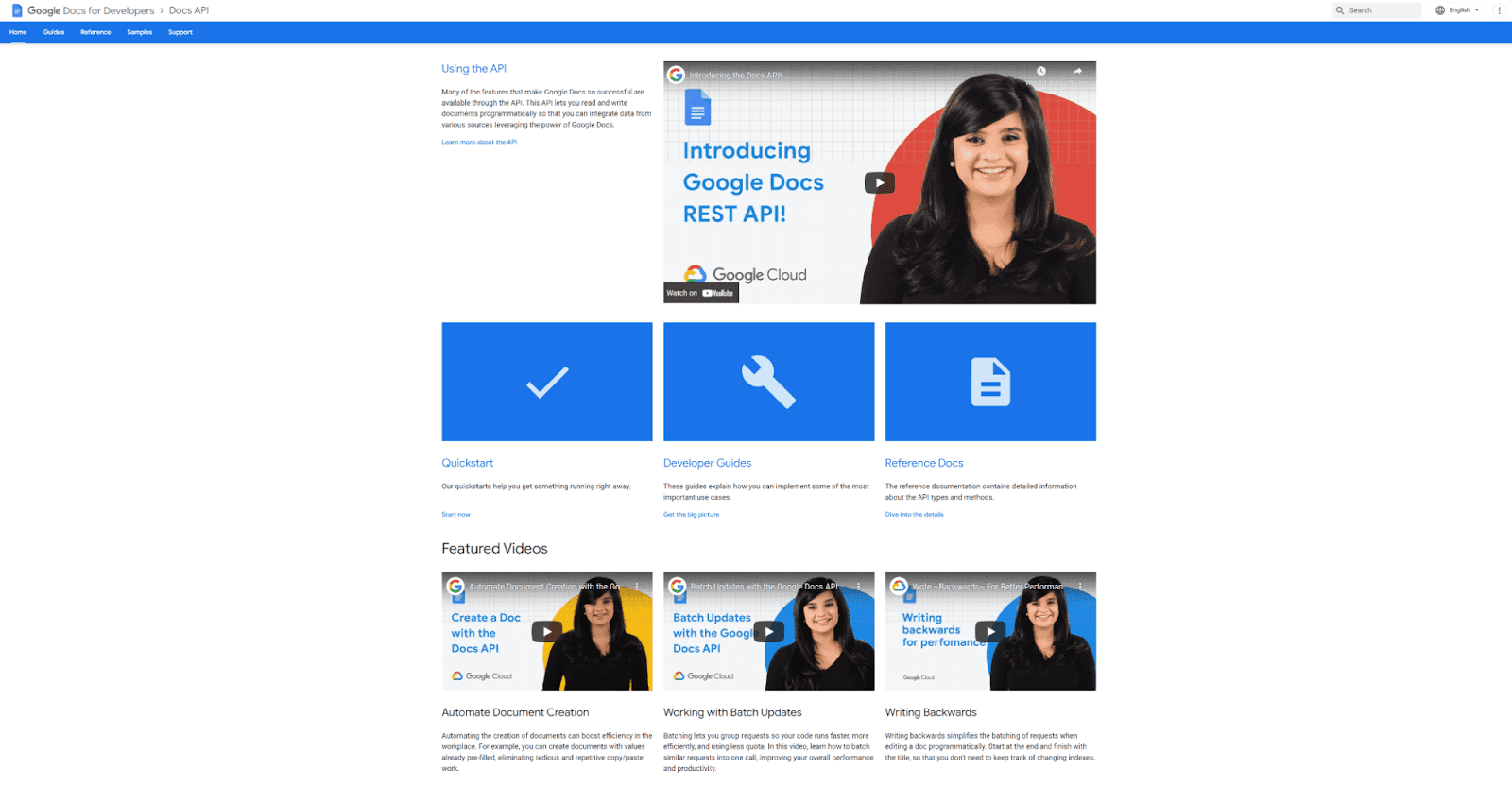
Source: Google
There are guides and references that no API documentation page should be without, but also videos and well-written copy that engages the visitor and motivates them to try out the API for themself.
So, in a nutshell, quality API documentation is a developer’s best friend when it comes to learning about an API and integrating it with their own product. If you ever wondered why developers are not using your APIs, you should check out blog post to learn more.
Not only does it represent a complete resource for working with the API, but it also plays an important motivational role in inspiring developers to create exciting new things using it.
Technical writers who are responsible for creating API documentation often face a unique set of challenges. One common issue is determining the appropriate level of technical detail to include in the documentation. Additionally, writers may struggle with organizing the documentation in a logical and intuitive manner, ensuring that users can quickly and easily find the information they need.
You should read our examples of questions technical writers face with API documentation.
Another common challenge is determining the appropriate balance between brevity and comprehensiveness, ensuring that the documentation is concise but still provides all the necessary information. Technical writers may also need to navigate complex API design choices, such as how to handle errors or manage authentication.
Writers must ensure that the documentation is accurate and up-to-date, as outdated or incorrect information can lead to user confusion and frustration. By understanding these challenges, technical writers can create effective and user-friendly API documentation that helps developers to use APIs with ease and efficiency.
Different Types of API Documentation
Different types of API documentation correspond to different needs of developers as they go through the entire process of working with the API.
With that in mind, we can divide API documentation into three distinct types:
- API reference: a catalog of all of the endpoints contained in the API that lays out the possibilities and tasks that can be achieved once the API is integrated.
- Guides and tutorials: these educational resources take the developer through the process of using the API and show them, step by step, how they can implement the endpoints described in the reference.
- Examples: Once the developer is deep in their work with the API, examples show them specific use cases for the API as well as how to fix commonly encountered problems. Here are the best API documentation examples with 11 companies that had a huge success.
To put this in the context of the API user journey, the API reference is great for providing an initial overview for newcomers to the API.
Once the basics are understood, guides and tutorials show developers how to work with the API to make integration as smooth as possible.
Finally, examples provide the developer with specific use cases and solutions once they become proficient and have the ability to adapt the API to the needs of their application or product.
Read recommendation: pros and cons of different types of API documentation.
Let’s look at an example for each type.
First off, here’s a quick look at Mailchimp’s API reference.
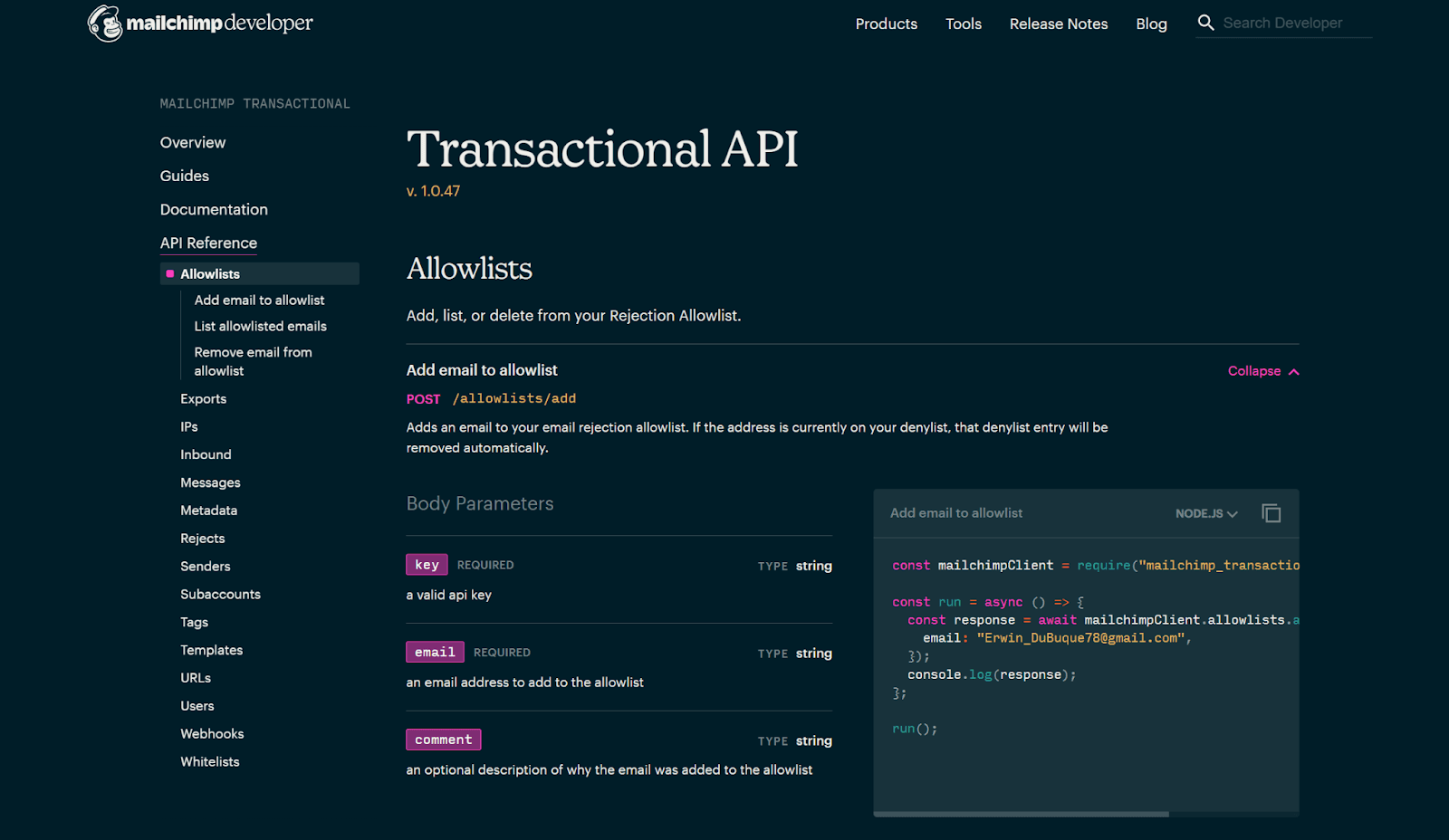
Source: Mailchimp
This specific entry is about adding an email address to an allow list (a list of trusted email addresses).
It briefly explains what this action does, its parameters and requirements, and goes on to show the developer what a successful response looks like.
There’s an entry like this one for every action that can be taken with the API.
Next up, let’s look at a great example of an API guide.
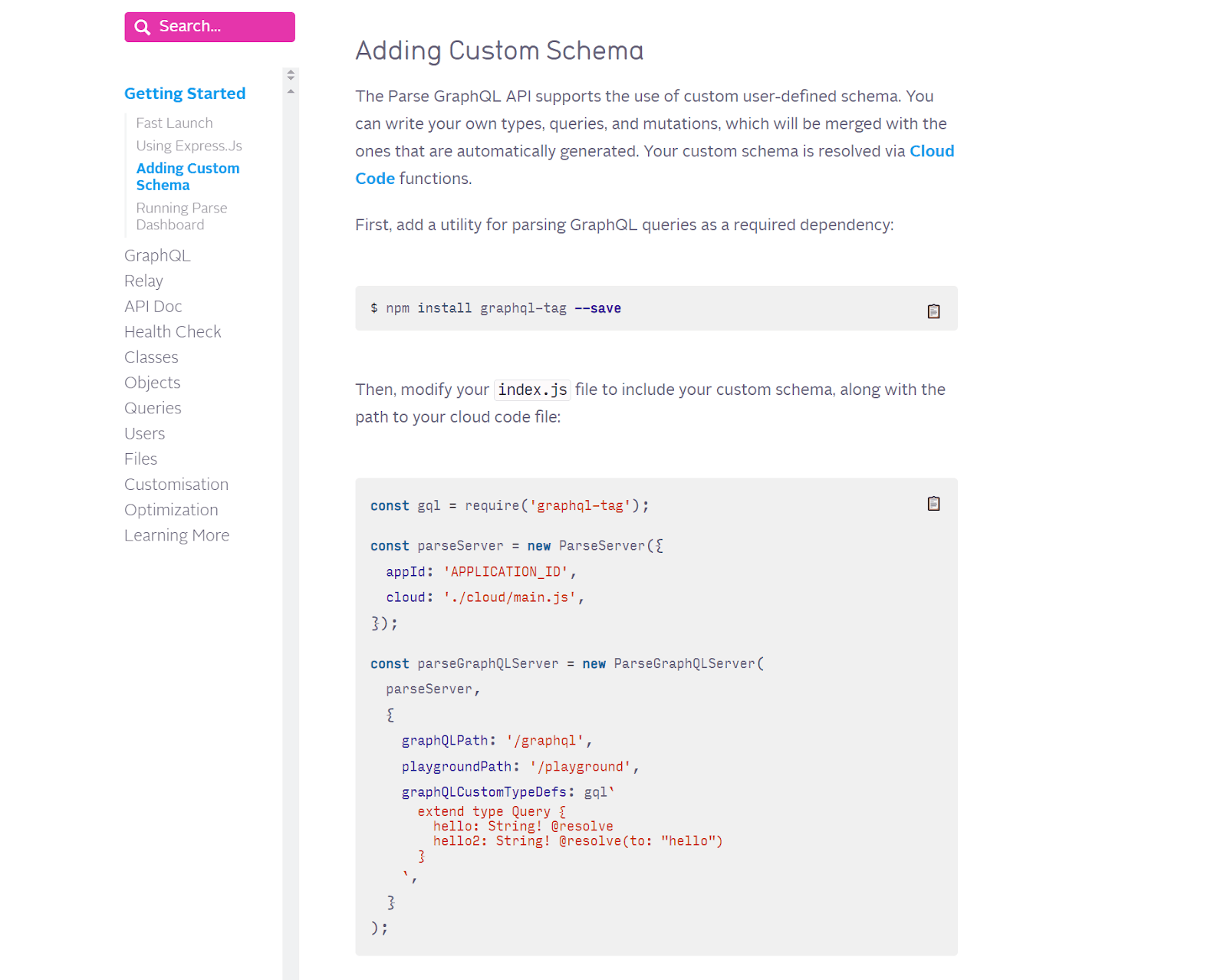
Source: Parse
Parse’s guide for setting up a custom schema follows a pretty standard routine for API guides.
The instructions are given as sequential steps written in plain English and each step is supplemented with a code snippet so that the user can see the implementation firsthand.
Last but not least, Spotify’s API documentation has an entire library of code examples that lets users complete various tasks using the API.

Source: Spotify
So if you wanted to know how exactly to display a user’s information with the API, all you need to do is click the appropriate example to see the code that does exactly that.
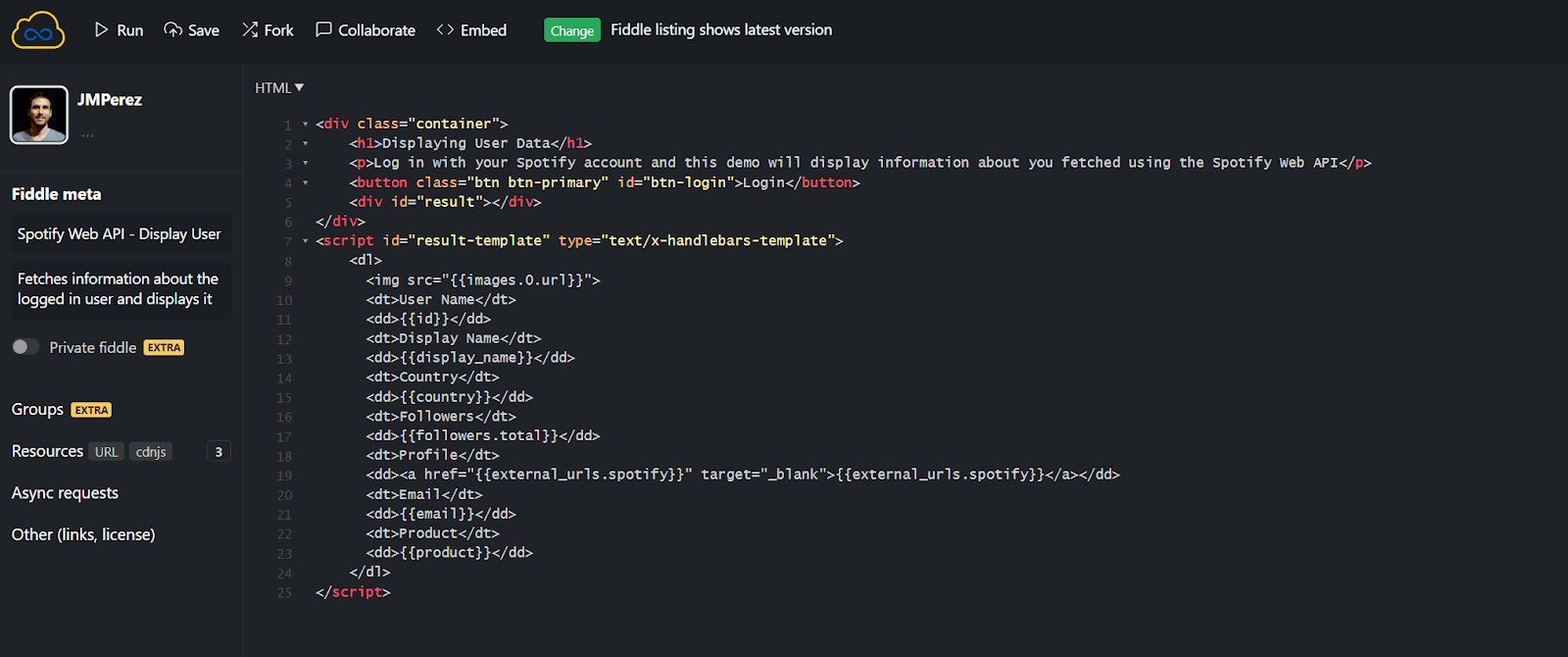
Source: Spotify
These three types of resources make up the bulk of API documentation and should be able to carry a developer from their initial contact with the API to the point when they become a proficient user who can accomplish all kinds of goals independently.
Should You Build Your Own API Documentation?
The short answer to this question is yes if you truly care about the experience of your API users. Here's how to improve the API developer experience!
Bear in mind what we said before about working with APIs.
They’re not necessarily intuitive for developers who need to integrate them into their work, so working with undocumented APIs can become very arduous very quickly.
In fact, developers will likely pass up on the opportunity of working with your API and instead look for a product that comes with quality guidance and well-explained use cases.

Source: Quora
That being said, you should also be aware that quality API documentation is one of the toughest types of technical documentation to create and you shouldn’t enter this task lightly.
If you need to document your API from scratch, you’ll probably need one technical API writer or developer to be dedicated to this project exclusively.
And once you’re done, your entire knowledge base will have to be continuously maintained and updated.
Nevertheless, a well-documented API brings a whole host of benefits.
For one, API documentation can seriously reduce onboarding time for new users.
Quality documentation will give them a strong starting point with your API and provide ways for them to immerse themselves in the code quickly.
That way, they can learn by doing and become well-versed with the API faster.
Consider the Quickstart feature that a lot of top-tier API documentation has. Here’s an example from Mailgun, an email optimization tool:
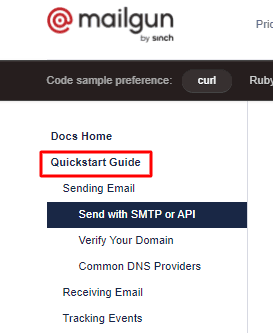
Source: Mailgun
Quickstart guides help users start doing things with the API as soon as they access the documentation, which helps them instantly understand how the API works. Here's a guide about how to read and understand API documentation!
In Mailgun’s example, the Quickstart guide shows the user how to send an email using a single curl command.
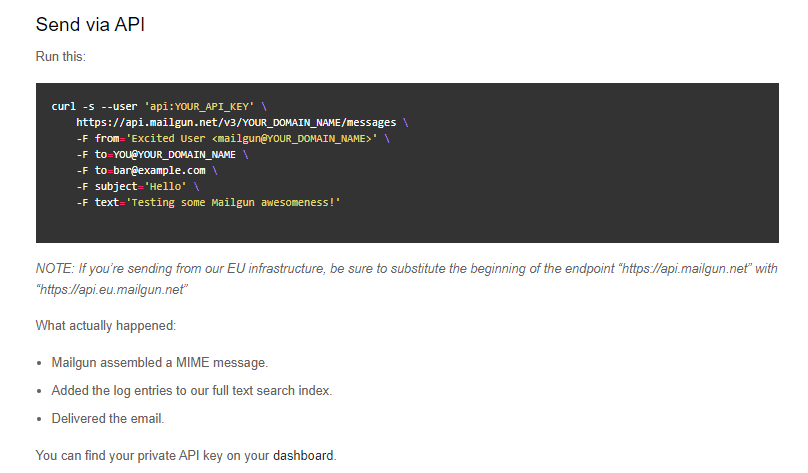
Source: Mailgun
Once the action is taken, the guide quickly explains what actually happened on the provider’s end, giving the developer an insight into the workings of the API.
Features like this help you orient your user and provide context on how the API works. That enables you to onboard them faster and come to productivity in no time.
With quick and efficient onboarding, users are much more likely to continue using your API.
This means your API documentation can play an important role in customer retention, which is evidenced by the fact that users are much more likely to keep using a service they actually understand.
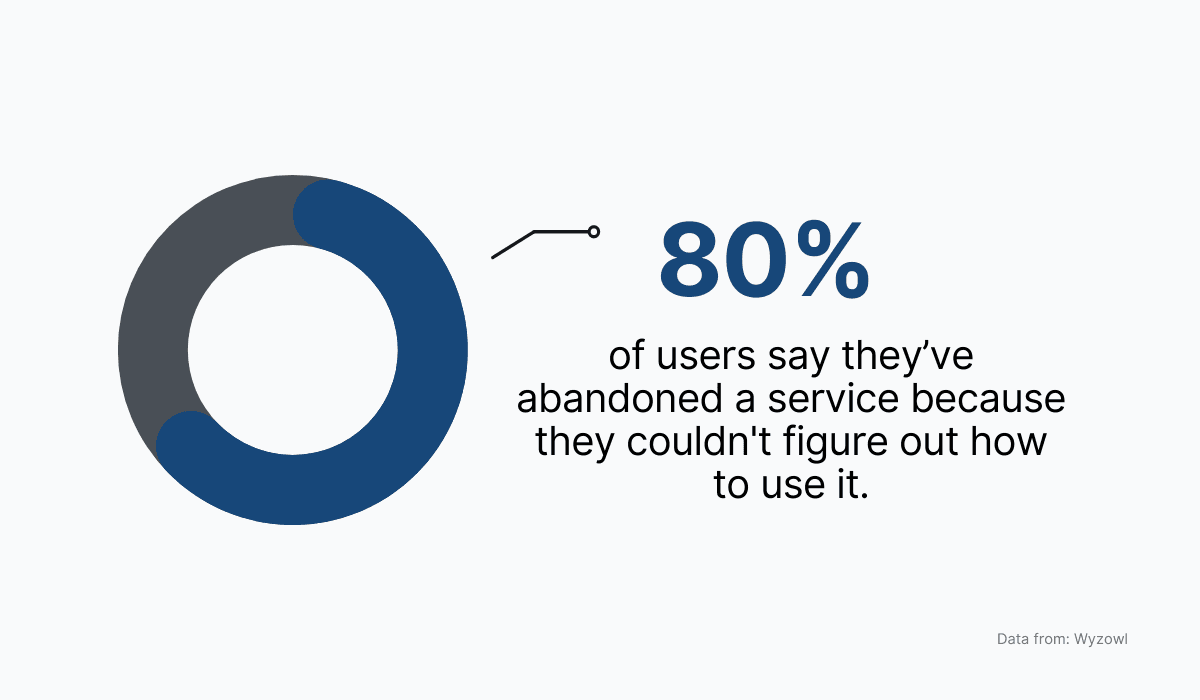
Source: Archbee.com
To go a step further, quality API documentation can even help you attract new customers. It’s easy to see why.
Developers who were able to become comfortable and successful with your API (thanks to the documentation, of course), are much more likely to recommend your API to colleagues working in the same field.
This happens all the time, especially with top-notch API documentation, like the one Stripe offers to their partner developers.
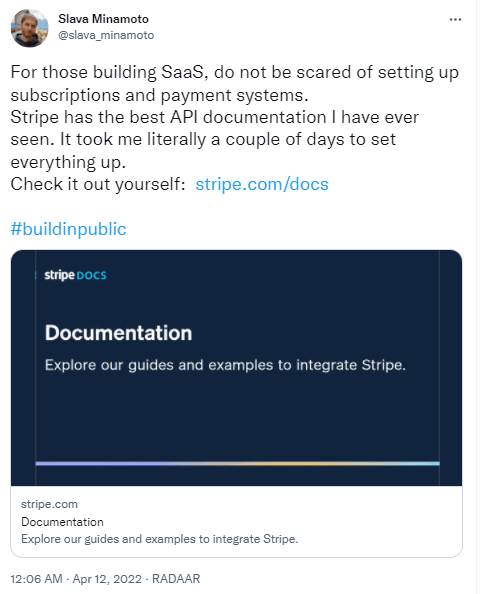
Source: Twitter
To sum up, creating API documentation is definitely worth the effort.
This resource has the power to help developers become successful users of your API faster and it also enables you to retain users and even attract new ones.
Tips for Creating Comprehensive API Documentation
Now that we’ve justified the need for creating documentation to go along with your API, let’s see if we can help you in your effort.
Here are our tips for creating comprehensive API documentation.
Start With an API Specification
A good practice to follow is to first create an overarching document that’s going to explain your API, detail its functionality, and describe its behavior.
All of this information is usually contained in the API specification.
A great feature of this document is that it’s both human and machine-readable, making it really easy for interested parties to identify your API as the perfect product for their needs.
There are a few formats you can use to write your specification, but the one that’s most commonly used is the one created by the OpenAPI initiative.
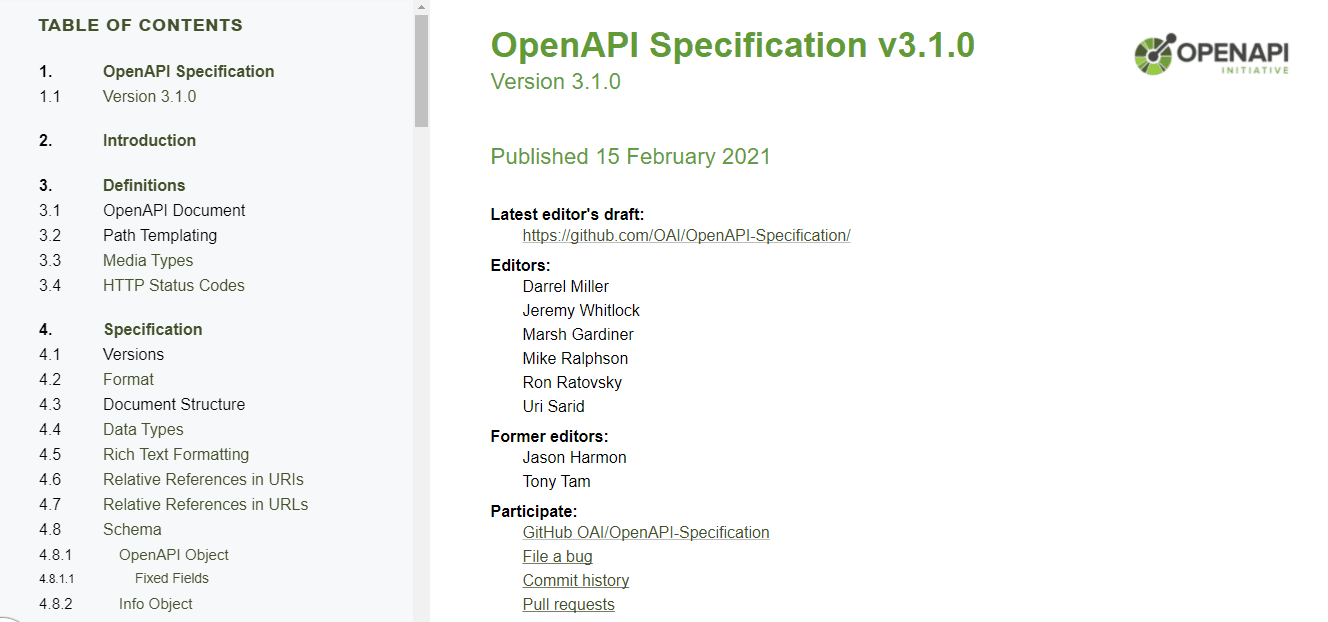
Source: OpenAPI
As you can see, the format itself has been standardized with a series of rules and regulations, so all you need to do is follow the prescribed steps.
Once your specification is finished, you should be left with a comprehensive explanation of your API that will inform your subsequent documentation writing, making it more efficient and consistent.
After all, when you have a clear roadmap to follow, mistakes along the way become much less likely. Speaking about mistakes, here is an article about most frequent mistakes to avoid in API documentation.
Include a Getting Started Guide
As we said before, developers need a clear starting point when they’re first encountering the API.
This allows them to become familiar with the framework of the API and begin understanding the value it could bring to their own work.
So, where do we begin?
Well, one of the most powerful things you can do to bring developers aboard is to allow them to perform the most basic action your API can do and show them the result.
In API terms, this could entail making a basic request and displaying the resulting response. GitHub’s API documentation does this quite well, for example:
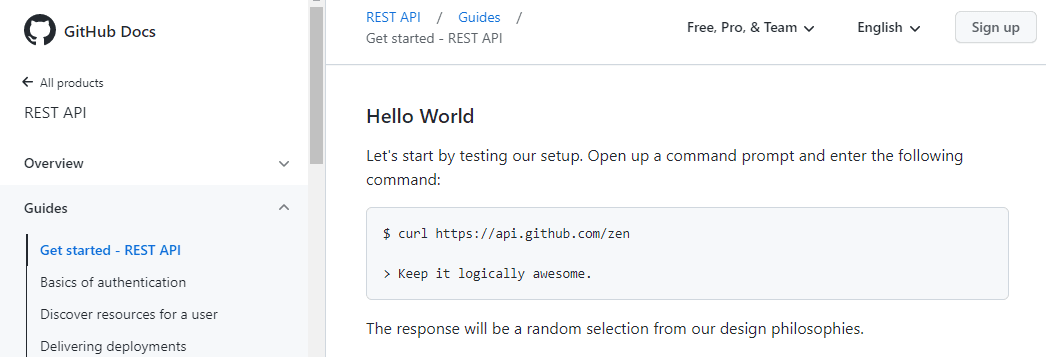
Source: GitHub
The new user runs a simple curl command that returns one of GitHub’s design philosophies.
In one easy step, they saw a preview of how the API works, as well as tested their setup to see if it would return the right response.
Some other elements API documentation designers like to include in the getting started guide are account signups and API key generation.
That makes sense because these are the elements the user won’t be able to access the API without. And speaking about API elements, we have for you and well organised blog post about elements no API document should be without.
SendGrid’s documentation is an excellent case in point here.
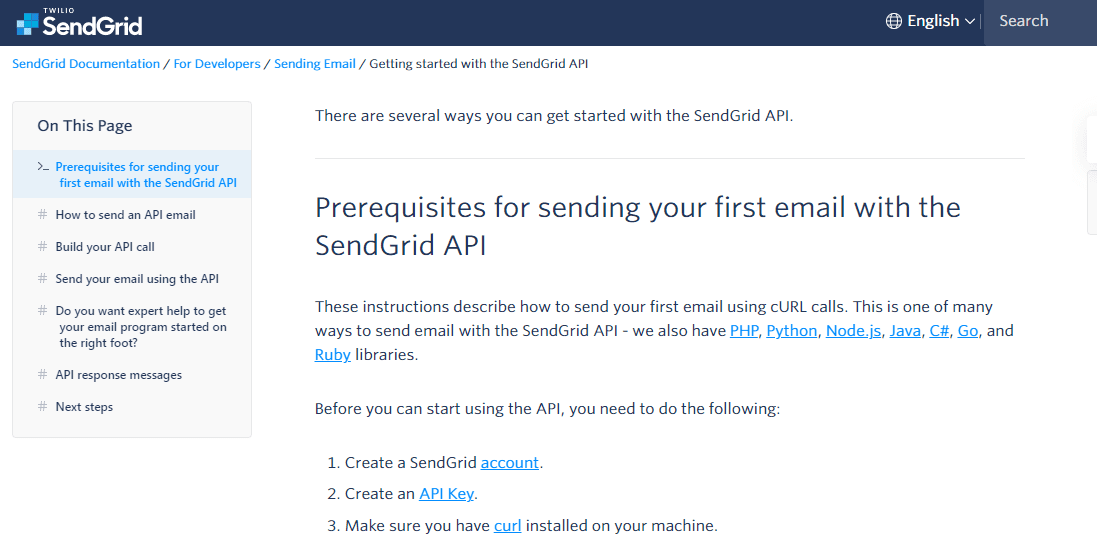
Source: SendGrid
As you can see, their start guide outlines the prerequisites for using the API, including an account, a working API key, and installed curl.
This is a great way to kick things off because the user won’t run into trouble once they’re deep in the API as they will have all the necessary elements to find success with the API.
With the introductions out of the way, it’s finally time for the fun part.
Add Additional Content
It’s no secret that developers enjoy playing around with code much more than reading line upon line of the theory behind the API.
To help users get their bearings, try to give them as much code as possible so that they can actually see the API in action, instead of just reading about it.
The most important aspect of API documentation to many developers are code examples where they can see how a request is structured and what they can expect in the response. We made for you an article about the importance of writing through API documentation for your company.
In fact, not enough examples is one of the biggest pet peeves developers mention when discussing API documentation.

Source: Twitter
In addition to that, some API documentation providers even include API explorers or sandboxes in the documentation.
These are safe spaces where developers can try out pieces of code without any consequences, that is without having to run them within their own applications when they’re not sure what the result will be.
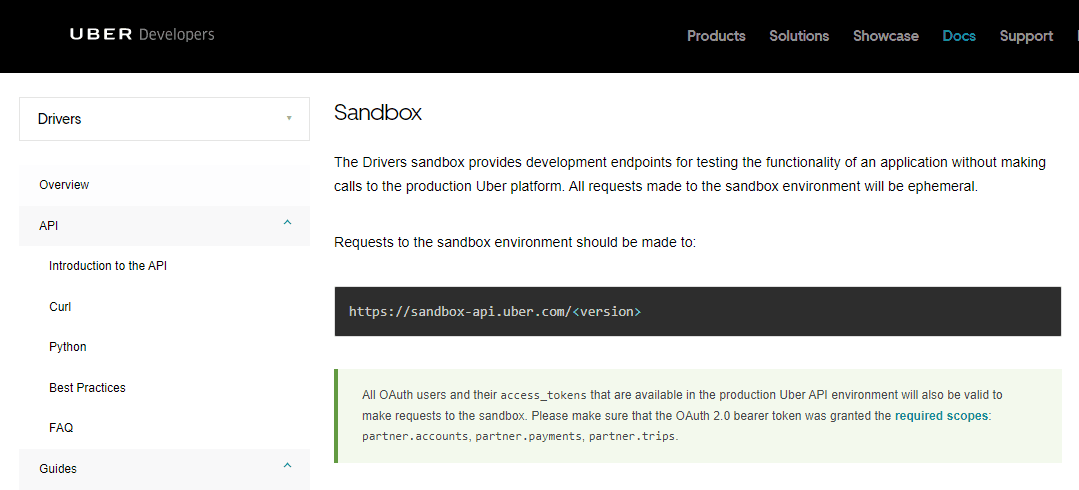
Source: Uber
The biggest players in the API game, such as Uber, PayPal, and eBay, all have such environments to enable developers to learn by doing in a simulated environment.
Sandboxes can be considered one of the flashier features of API documentation, but they’re well worth the investment.
But don’t worry if you aren’t able to provide an API explorer right away. Just make sure your documentation is covered with code examples as much as possible and then work from there.
Create API documentation checklist
Creating API documentation can be a daunting task, especially for new technical writers. That's why an API documentation checklist can be a useful tool to ensure that no important details are missed.
The checklist typically includes items such as an overview of the API's purpose, instructions for authentication, sample requests and responses, error handling information, and any required parameters.
Other items might include API version information, endpoint descriptions, and any relevant examples or tutorials. In addition to ensuring that all necessary information is included, the checklist can also help to ensure consistency and clarity throughout the documentation.
By following an API documentation checklist, technical writers can create documentation that is informative, accurate, and easy to use, saving developers valuable time and effort.
Use a Great Documentation Platform
One thing your API documentation won’t be able to do without is a quality documentation platform where your documents will be hosted.
That’s because only specialized software has everything you need to offer comprehensive, interactive, code-rich documentation that’s going to do your API justice.
Our own platform, Archbee, was uniquely designed to cater to an API documentation provider’s every need.
To start with, it allows you to publish branded documentation in your own domain so that it’s accessible to everyone (everyone with the right credentials, at least), at any time and from anywhere.
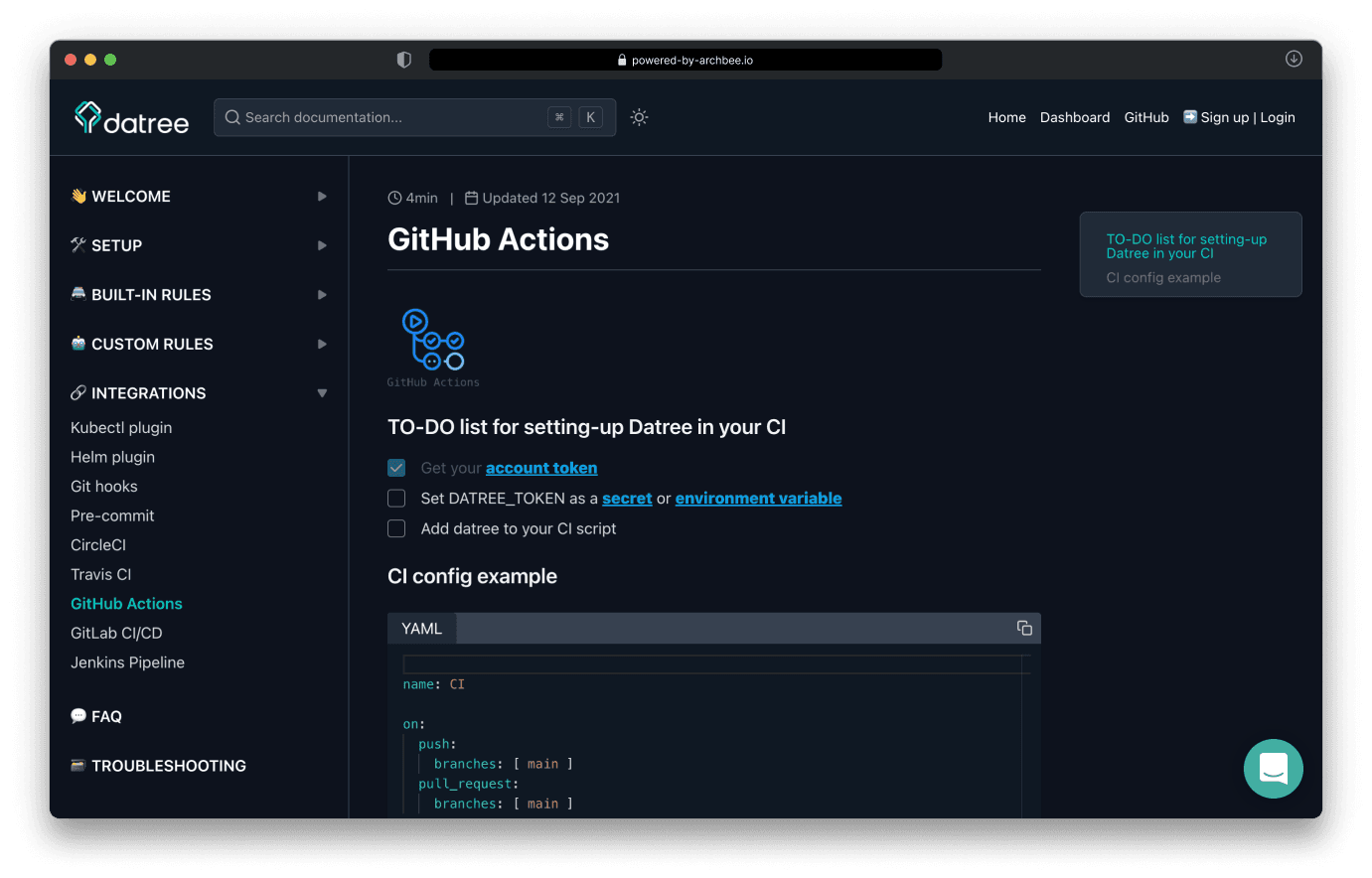
Source: Archbee
It features a great user experience for documentation providers with everything you need to keep your API documentation fresh and up to date, including a verification function that will alert document owners when it’s time to verify that a specific document is still accurate and current.
Source: Archbee
Most importantly, Archbee offers the highest level of support for API integrations.
It allows you to import your entire API reference using OpenAPI files, or add single API endpoints with all the bells and whistles (name, methods, parameters, code examples).
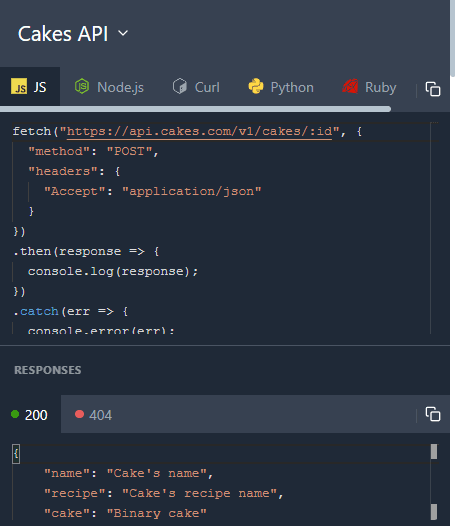
Source: Archbee
Of course, all of this is available in multiple programming languages, thanks to the integrated multi-language editor.
API documentation is intended for developers, which means every topic needs to be supplemented with good code.
That’s why a quality documentation platform is your best bet for creating API documentation developers will actually enjoy.
Conclusion
We hope this beginner guide to API documentation was successful in demystifying this unique type of technical documentation.
In this article, we presented you with the theory and practice of creating helpful API documentation developers will enjoy reading.
All that’s left for you is to apply these lessons and start documenting the API you’ve been working so hard on.
FAQ
Frequently Asked Questions
API documentation is the developer-facing guide to your API. It explains what the API does and how to use it—authentication, endpoints, parameters, request/response formats, data models, errors, and rate limits. Great docs typically combine a concise reference, getting-started and deeper guides, and runnable examples so developers can evaluate, integrate, and troubleshoot quickly. They’re created and maintained by technical writers and engineers and published on a dedicated docs site, then kept current as the API evolves.



